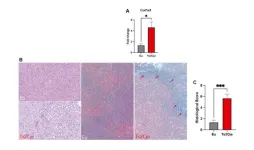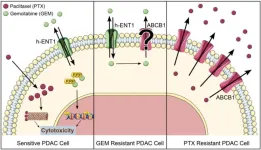(Press-News.org) Researchers have identified unique 3-dimensional features called TULIPs in the genome of posterior fossa group A (PFA) ependymoma, a difficult-to-treat brain tumor diagnosed in very young children. The findings, published in Cell by a team of researchers at Baylor College of Medicine, Texas Children’s Hospital, McGill University and collaborating institutions, could lead to the development of new treatments.
“PFA ependymomas are lethal. Radiation therapy, the only treatment currently available, is not curative and can cause serious developmental and cognitive issues,” said co-corresponding author Dr. Marco Gallo, associate professor of pediatrics, hematology-oncology at Baylor and Texas Children’s. “One of the reasons for the little progress in the development of effective treatments for PFA is that most of these tumors lack clear genetic mutations driving their growth. Without a clear therapeutic target against which we could design specific treatments, we took another approach and investigated the DNA packaging inside the nucleus of the cell.”
Every cell in the body has about 6.6 feet (2 meters) of linear DNA that is stored in its nucleus in a manner that enables the cell to easily access the genes it uses most often while setting aside those used less frequently. This would be like organizing a closet with the clothes most frequently used at the front and those rarely worn on the back. To fit in the tiny nucleus, the long DNA molecules are folded, twisted and looped, which results in specific 3D conformations, some tighter, some more relaxed, that can ultimately help the cell express the genes needed to do its job.
Very little is known about how pediatric brain tumor cells organize their genomes in 3D. “In this study, we used Hi-C technology to profile the 3D architecture of entire genomes of pediatric PFA ependymomas and compared them with those of different tumor types and non-malignant tissues,” said Dr. Michael D. Taylor, co-senior author of the study and professor of pediatrics, hematology – oncology and neurosurgery at Baylor and Texas Children’s. He also is the Cyvia and Melvyn Wolff Chair of Pediatric Neuro-Oncology at Texas Children's Cancer and Hematology Center. “We discovered PFA ependymoma-specific 3D genome features that recur at predictable genomic locations. Interestingly, these features are not present in other types of pediatric brain cancer. We call them TULIPs, which stands for Type B Ultra-Long Interactions in PFAs.”
TULIPs are specific regions of very tightly compacted, thus hard to access, DNA, a sign that the cell may not use the genes in that region often. “TULIPs also tend to interact with each other over very long distances. TULIPs at opposite ends of a chromosome can find ways to interact with surprising strength,” Gallo said. “TULIPs on different chromosomes can also converge and strongly interact with each other. We also found that the DNA in regions outside TULIPs appears more relaxed. This is important because TULIPs are linked to the cell’s function.”
TULIPs carry a chemical tag, specifically a methyl group on histone H3K9, a protein associated with DNA. “We found that inhibiting the tagging of H3K9 in PFA patient-derived cultures leads to weaker interactions between TULIPs and an overall decrease in PFA ependymoma cell survival,” Gallo said. “Collectively our data indicate that aggregation of TULIPs in the 3D nuclear space of PFA cells depends on the maintenance of robust levels of methylated H3K9 histones, and that TULIP interactions are important for PFA cell viability, opening new potential venues for treatments.”
“The mechanism by which TULIPs mediate cancerous behavior is not entirely understood,” Gallo said. “Our goal is to further investigate how TULIPs arise and influence PFA ependymoma development. The uniqueness of TULIPs in these high-risk tumors has motivated us to investigate treatment strategies directed at them to promote tumor elimination.”
Other contributors to this work include Michael J Johnston, John JY Lee, Bo Hu, Ana Nikolic, Elham Hasheminasabgorji, Audrey Baguette, Seungil Paik, Haifen Chen, Sachin Kumar, Carol CL Chen, Selin Jessa, Polina Balin, Vernon Fong, Melissa Zwaig, Antony MichealRaj, Xun Chen, Yanlin Zhang, Srinidhi Varadharajan, Pierre Billon, Nikoleta Juretic, Craig Daniels, Amulya Nageswara Rao, Caterina Giannini, Eric M Thompson, Miklos Garami, Peter Hauser, Timea Pocza, Young Shin Ra, Byung-Kyu Cho, Seung-Ki Kim, Kyu-Chang Wang, Ji Yeoun Lee, Wieslawa Grajkowska, Marta Perek-Polnik, Sameer Agnihotri, Stephen Mack, Benjamin Ellezam, Alex Weil, Jeremy Rich, Guillaume Bourque, Jennifer A Chan, V Wee Yong, Mathieu Lupien, Jiannis Ragoussis, Claudia Kleinman, Jacek Majewski, Mathieu Blanchette and Nada Jabado. Find the authors’ affiliations in the publication.
This work was supported by a Large-Scale Applied Research Project grant from Génome Quebec, Genome Canada, the Government of Canada and Ministère de l’Économie et de l’Innovation du Québec, with the support of the Ontario Research Fund through funding provided by the Government of Ontario. Further support was provided by Brain Canada Foundation through the Canada Brain Research Fund, Health Canada and the Azrieli Foundation through an Azrieli Future Leader in Canadian Brain Research grant, Canadian Institutes of Health Research (CIHR) project grants (PJT-156278 and PJT-173475), a CIHR postdoctoral fellowship and a Canada Research Chair and Texas Children’s Hospital.
###
END
PFA ependymoma brain tumors display unique 3D genome features that could be exploited therapeutically
2024-07-10
ELSE PRESS RELEASES FROM THIS DATE:
SLAC’s high-speed electron camera uncovers a new ‘light-twisting’ behavior in an ultrathin material
2024-07-10
While taking snapshots with the high-speed “electron camera” at the Department of Energy’s SLAC National Acceleratory Laboratory, researchers discovered new behavior in an ultrathin material that offers a promising approach to manipulating light that will be useful for devices that detect, control or emit light, collectively known as optoelectronic devices, and investigating how light is polarized within a material. Optoelectronic devices are used in many technologies that touch our daily lives, including ...
Jump start your science career: DOE applications for 2025 student internships now open
2024-07-10
WASHINGTON, DC – Applications are currently being accepted for the Spring 2025 term of two programs offered by the Department of Energy (DOE) Office of Science (SC): the Science Undergraduate Laboratory Internships (SULI) program and the Community College Internships (CCI) program. The application deadline for the two programs is 5:00 pm (ET) October 2, 2024.
Through the SULI and CCI programs, undergraduate students and recent graduates discover science and technology careers at the DOE national laboratories and gain the experience ...
New guidance for healthcare professionals to address muscle-building supplement use
2024-07-10
Toronto, ON – In a groundbreaking effort to mitigate the risks associated with muscle-building dietary supplement use among adolescents and young adults, a comprehensive set of guidelines has been introduced to assist healthcare professionals. These guidelines, published in the Journal of Adolescent Health, focus on assessment and harm reduction strategies to better support young individuals engaged in the use of these readily available supplements.
Muscle-building dietary supplements, such as whey protein and creatine monohydrate, are commonly used by adolescents and young adults, particularly boys and young men, and are intended to enhance muscle mass, ...
It is possible to predict cognitive decline in Alzheimer's disease
2024-07-10
Amsterdam UMC's Alzheimer Centre has developed a prediction model that can predict cognitive decline in patients with mild cognitive impairment or mild dementia due to Alzheimer's disease. The next step is developing an app that uses this prediction model, which would represent an important step towards personalised forecasts for patients. The study is published today in the journal Neurology.
After people have been diagnosed with Alzheimer's, their first question is often: "What can I expect now?". This question is difficult ...
Can we predict how fast cognitive decline will occur with early Alzheimer’s?
2024-07-10
MINNEAPOLIS – A new study looks at predicting how quickly people with early Alzheimer’s disease will experience cognitive decline. The study is published in the July 10, 2024, online issue of Neurology®, the medical journal of the American Academy of Neurology. It also looked at how the new drugs recently approved for the disease may reduce decline.
“The rate of cognitive decline varies greatly from person to person, and people are very interested in what to expect from the disease in themselves or their loved ones, so better prediction models are urgently needed,” said study author Pieter J. van der Veere, M.D., of Amsterdam ...
New Consumer Food insights from Purdue explores consumer attitudes toward U.S. farm bill
2024-07-10
The general public has limited knowledge of the U.S. farm bill that politicians are debating on Capitol Hill, according to the June 2024 Consumer Food Insights (CFI) Report.
The survey-based report out of Purdue University’s Center for Food Demand Analysis and Sustainability (CFDAS) assesses food spending, consumer satisfaction and values, support of agricultural and food policies, and trust in information sources. Purdue experts conducted and evaluated the survey, which included 1,200 consumers across the U.S
“Around one-third ...
Lion with nine lives breaks record with longest swim in predator-infested waters
2024-07-10
A record-breaking swim by two lion brothers across a predator-infested African river has been documented in a study co-led by Griffith University and Northern Arizona University.
Dr Alexander Braczkowski, from Griffith’s Centre for Planetary Health and Food Security, led a team that filmed a two-male lion coalition crossing the Kazinga Channel in Uganda at night, using high-definition heat detection cameras on drones. The work was done under the supervision of the Uganda Wildlife Authority.
One half of the lion brother duo was a 10-year-old ...
Pumpkin disease not evolving, could make a difference for management
2024-07-10
URBANA, Ill. -- The pathogen that causes bacterial spot is very good at what it does. Forming small lesions on the rinds of pumpkins, melons, cucumbers, and other cucurbits, it mars the fruits’ appearance and ushers in secondary pathogens that lead to rot and severe yield loss. The bacterium, Xanthomonas cucurbitae, is so successful that it has had no reason to evolve through time or space. That’s according to new University of Illinois Urbana-Champaign research characterizing ...
Aging exacerbates oxidative stress and liver fibrosis in an animal model of Down Syndrome
2024-07-10
“[...] our results put the basis for the use of antioxidants supplementation in Down Syndrome patients to prevent liver-associated pathologies.”
BUFFALO, NY- July 10, 2024 – A new research paper was published in Aging (listed by MEDLINE/PubMed as "Aging (Albany NY)" and "Aging-US" by Web of Science) Volume 16, Issue 12, entitled, “Aging exacerbates oxidative stress and liver fibrosis in an animal model of Down Syndrome.”
Down Syndrome (DS) is a common genetic disorder characterized by an extra copy of chromosome 21, leading to dysregulation of various metabolic pathways. Oxidative stress in DS is associated ...
Targeting ABC transporters in PDAC – past, present, or future?
2024-07-10
“[...] it is crucial for the future application of ABC transporter inhibitors [...] to develop a stratification protocol [...] to identify those PDAC patients who are most likely to benefit from chemosensitization induced by these inhibitors.”
BUFFALO, NY- July 10, 2024 – A new editorial paper was published in Oncotarget's Volume 15 on June 20, 2024, entitled, “Targeting ABC transporters in PDAC – past, present, or future?”
In this new editorial, Cecilia Bergonzini, Elisa Giovannetti and Erik ...




